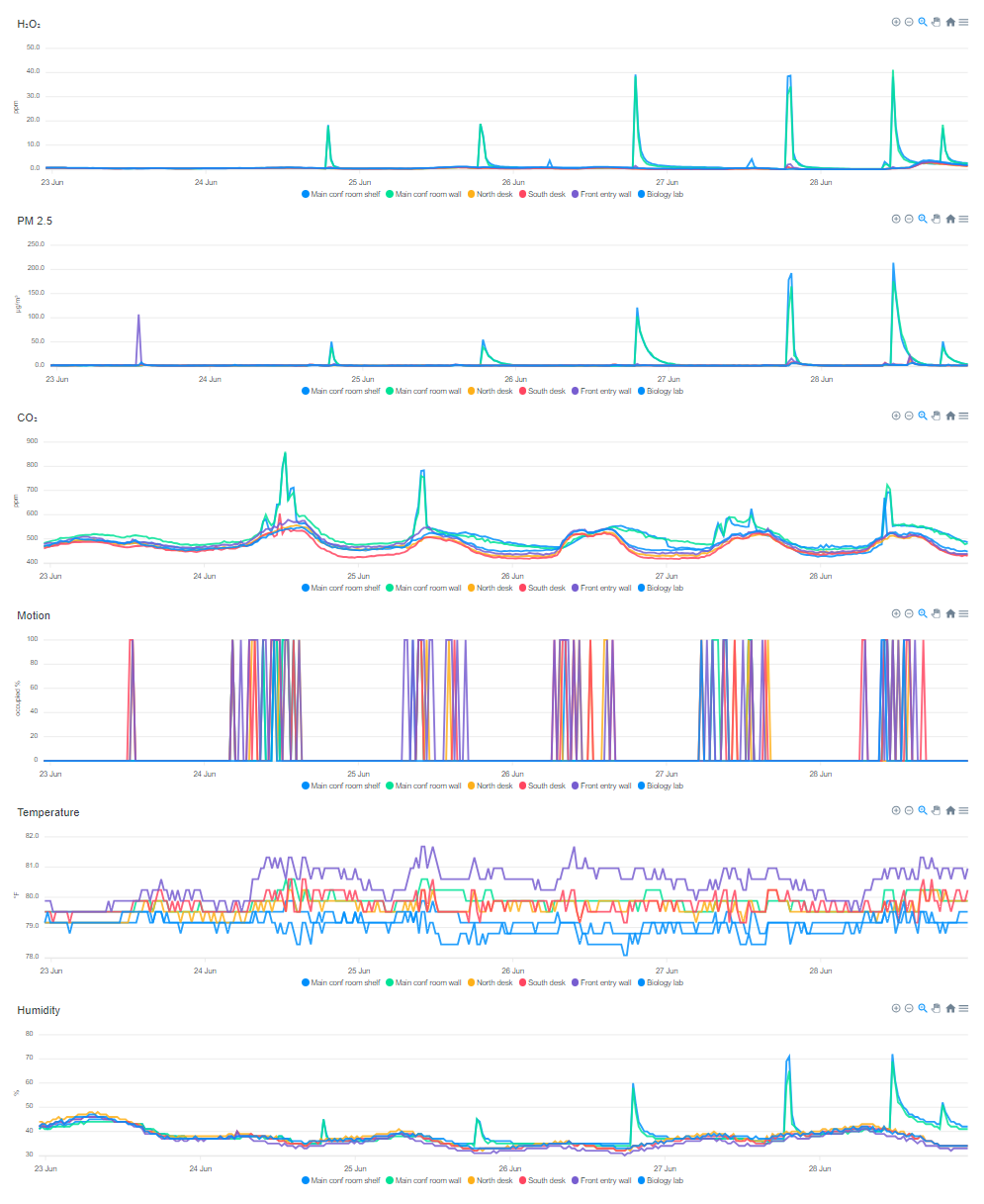Breezy Sense™
A smart IoT sensor for monitoring disinfection cycles, air quality, occupancy, and environmental conditions within indoor spaces.


As part of the Breezy Platform™, Breezy Sense™ measures multiple facility health parameters including hydrogen peroxide to optimize disinfection dosages, carbon dioxide and motion to monitor occupancy, particulate matter for air pollutants, and temperature and humidity for facility comfort levels. Breezy Sense can trigger disinfection by Breezy Blue™ to optimize the use of chemical and custodian labor. All historical data is captured within the Breezy Cloud™ data warehouse which helps to optimize and promote a facility’s health.
Facility Data within Breezy Cloud™
Breezy Sense monitors real-time facility health parameters that are logged within the Breezy Cloud data warehouse.
- Aerosolized Hydrogen Peroxide (aHP) for disinfection levels and reentry notifications
- Particulate matter (PM2.5) and Carbon Dioxide for indoor air quality
- Motion detection for occupancy
- Temperature and humidity for environmental conditions
The Breezy Cloud data includes time tags and location tags that offer keen insights into indoor health, energy usage, janitorial workflow efficiencies, and the environmental comfort within a commercial facility.

Why IAQ Matters
Healthy Indoor Spaces
We spend 90% of our time indoors - at home, work, school, and other indoor environments. Indoor air quality (IAQ) significantly impacts our health and well-being. The indoor air we breathe can contain pollutants, pathogens, or allergens that may lead to various health issues, including allergies, asthma, and respiratory diseases. Common indoor pollutants include dust mites, mold, pet dander, outdoor air pollution, and volatile organic compounds (VOCs) emitted from household products. Maintaining good indoor air quality is essential for creating a healthy and comfortable living environment, promoting overall well-being and productivity. Regular ventilation, proper cleaning practices, and minimizing the use of certain chemicals are crucial steps to ensure that the indoor air we breathe supports optimal health.
Indoor Carbon Dioxide
Indoor carbon dioxide (CO2) is produced by people exhaling within shared spaces. In well-ventilated areas, CO2 levels remain low, indicating a sufficient exchange of outdoor and indoor air. However, in poorly ventilated spaces, CO2 concentrations will rise with high occupancy, leading to potential health concerns. High levels of CO2 have been shown to cause discomfort, drowsiness, and cognitive decline1,2. Additionally, high levels of indoor CO2 equate to the potential for high levels of disease-causing pathogens that are also exhaled into the air by people. Monitoring indoor CO2 is a good way to assess the health and ventilation of your indoor spaces.
Indoor Particulate Matter
PM2.5, or particulate matter with a diameter of 2.5 micrometers or smaller, is commonly used to measure outdoor air pollution from sources like combustion engines, industrial processes, and smoke. PM2.5 can also be a significant contributor to indoor air pollution with potentially adverse health effects. These fine particles can easily penetrate indoor spaces. Once indoors, PM2.5 particles can linger in the air for extended periods, posing health risks as they are small enough to be inhaled into the respiratory system. The adverse effects of prolonged exposure to PM2.5 include respiratory and cardiovascular issues, exacerbation of pre-existing conditions like asthma, and an increased risk of respiratory infections. To mitigate the impact of PM2.5 on indoor air quality, proper ventilation, air purifiers, and reducing indoor sources of pollution are crucial measures to ensure a healthier indoor space.

